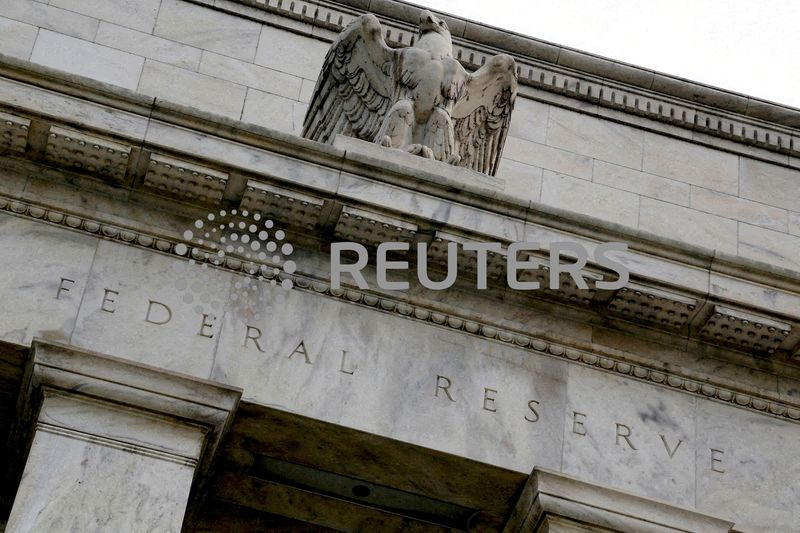By Lindsay (NYSE:LNN) Dunsmuir and Ann Saphir
(Reuters) -U.S. economic activity expanded at a slight to modest pace from late May through early July with firms expecting slower growth ahead as they also reported signs the jobs market continues to soften, in line with the Federal Reserve's recent pivot to more keenly assessing slowing demand for labor to ensure it doesn't wait too long before cutting interest rates.
The U.S. central bank's latest temperature check on the health of the economy also showed that inflation pressures increased at a modest pace with most Fed districts reporting input costs were beginning to stabilize.
"Economic activity maintained a slight to modest pace of growth in a majority of districts this reporting cycle," the Fed said in its survey released on Wednesday, which polled business contacts across the central bank's 12 districts through July 8.
While seven Fed districts reported some level of increase in activity, five noted flat or declining activity - three more than in the prior reporting period, the survey noted, as firms forecast a dimming outlook.
"Expectations for the future of the economy were for slower growth over the next six months due to uncertainty around the upcoming election, domestic policy, geopolitical conflict, and inflation," the Fed survey said.
In particular, the upcoming U.S. presidential election in November was increasingly on business contacts' minds, the report showed. The Atlanta Fed said uncertainty about the election outcome appeared to be weighing on investment activity in the renewable energy space, while the Dallas Fed said outlooks from the manufacturing and construction and real estate sectors were clouded by election uncertainty, for example.
The Fed's analysis, released roughly every six weeks, comes as Fed Chair Jerome Powell and his colleagues have emphasized that risks on inflation and jobs are now in balance. Earlier on Wednesday two top Fed officials said interest rate cuts are "getting closer," remarks that appear to set the stage for a lowering of borrowing costs in September.
After being stung by higher-than-expected inflation in the first part of this year, Fed officials have been encouraged by more positive readings in April, May and June. Inflation remains, by the Fed's preferred measure, at 2.6%. The next release of that gauge is due on July 26.
As disinflation has resumed, Fed officials have more strongly spoken about a marked deterioration in the labor market as a reason the central bank would begin to cut its policy rate.
PAUSING SOME HIRES
Several districts noted softer labor market conditions. A Wisconsin source told the Minneapolis Fed there were "still plenty of job openings," but employers were raising hiring standards and pausing on some hires, the bank reported.
One contractor told the Philadelphia Fed they had received 20 applications for electrical jobs— "the most I have seen in the last 20 years."
Fed officials recently have said the labor market has come into better balance thanks to an influx of workers, many of them foreign born, a development also represented in Wednesday's report. The Boston Fed said Cape Cod contacts noted normal levels of availability of foreign-born workers through short-term visa programs, which support the seasonal labor demand in the area.
The Fed is trying to engineer a so-called "soft landing" for the economy in which economic growth gradually slows and the unemployment rate remains low even as inflation, which spiked to a 40-year high two years ago, returns to the Fed's 2% target rate.
The unemployment rate hit a 2-1/2-year high of 4.1% in May and annual wages increased at the slowest pace in three years amid an expanding labor pool, the latest government data showed.
The Fed survey described wage gains as growing at a modest to moderate pace in most districts, although several reported a slowing of wage growth.
And while there were more encouraging signs that inflation is ebbing, Fed banks also heard multiple accounts of inflation continuing to weigh on households, impacting spending.

"Financial stress from elevated costs, particularly for rent, reportedly pushed families to move in together and individuals to find roommates to help pay rent," the San Francisco Fed said. "Overall, contacts indicated that discretionary purchases were down, in particular for lower-income households," reported the Cleveland Fed.
The Fed's benchmark overnight lending rate has been held in the range of 5.25% to 5.50% for the past year. While policymakers have all but ruled out a cut at the upcoming meeting on July 30-31, investors currently expect the Fed to lower borrowing costs in September, November and December this year.